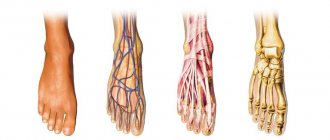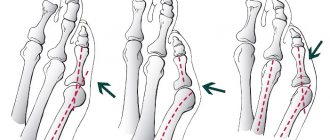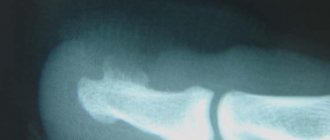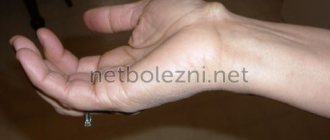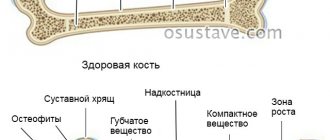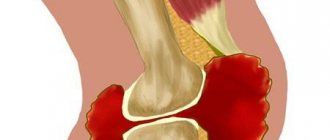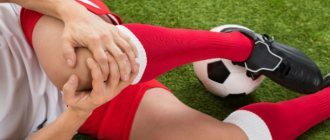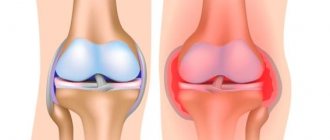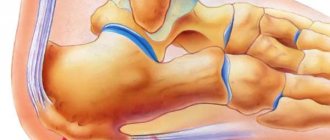Osteophytes
- bone growths that form on articular surfaces are not an independent disease. More often they indicate the presence of some underlying pathological process in the musculoskeletal system.
At the same time, osteophytes themselves are, perhaps, one of the most striking diagnostic symptoms for an orthopedist or rheumatologist. Bone outgrowths are clearly visible during X-ray examination of diseased joints, and also serve as a cause for aggravation of a whole complex of symptoms - pain, inflammation, joint deformation.
Osteophytes are bone growths that indicate a disorder in the human musculoskeletal system.
Left untreated, osteophytes begin to grow, pushing apart and injuring the soft tissue with every movement in the joint. In advanced cases, they completely block the joint
- but even then the pain does not subside due to compression and irritation of the nerve endings.
Inflammation becomes chronic and plagues patients, including
at night , affecting the quality of sleep and mood. The condition of the joints also worsens, ligaments and muscles weaken. After all, osteophytes are essentially foreign bodies that disrupt the natural anatomical position of the ligaments and interfere with the normal passage of nutrients into the tissue. Osteophytes of the spine can lead to compression of the nerve roots, which directly affect the functioning of the heart, lungs, genitourinary system and other internal organs, as well as a person’s ability to move and self-care.
To prevent severe impairment of motor function and chronic inflammation, osteophytes should be treated in advance.
. And in some cases, even think about their prevention. What should you know about this invisible enemy?
Causes of osteophytes
Osteophytes form on bones in cases where the joints require compensatory support. If a joint is unable to perform its shock-absorbing function due to benign wear and tear or chronic diseases, the edges of the bones begin to touch and rub against each other. This leads to irritation of the periosteum (periosteum). Since the periosteum plays a huge role in the blood supply (and therefore nutrition) of the surface layers of bone, they begin to experience nutritional deficiencies and become vulnerable to mechanical abrasion. The periosteum also participates in the processes of bone tissue formation (it is thanks to it that the so-called callus grows on injured areas of the bone). The combination of these two factors (a decrease in bone strength and irritation of the areas that are responsible for its growth) results in the formation of osteophytes - first in the form of tubercles or small protrusions. Subsequently, they can take almost any form - a spike, a hook, a visor and others.
Cause the development of osteophytes
can:
- degenerative-dystrophic processes and diseases of bone and cartilage tissue
; - injuries
(not only bones and joint capsule, but also ligaments and soft tissues near the joint); - metabolic and endocrine diseases
(diabetes mellitus, gout, rickets); - congenital and acquired curvatures of posture and feet
(scoliosis, lordosis, kyphosis, flat feet); - inflammatory diseases of bone tissue
(tuberculosis bone infection, brucellosis); - autoimmune diseases
(rheumatoid arthritis, psoriasis); - unnaturally high load on the joints
(excess weight, professional and amateur sports, professions associated with physical labor, shifting the center of gravity during pregnancy); - oncological diseases
(both tumors with primary localization in the bone and metastases of other neoplasms).
The risk of osteophyte formation is increased by genetic predisposition, bad habits and poor environmental conditions. The progression of the problem can be affected by any factor that directly affects bone strength (for example, hormonal imbalances, stress, age-related changes, physical inactivity).
Most often, osteophytes are observed in older people, but the onset of the pathological process often occurs at the age of 40 years. Therefore, starting from this milestone, you should begin to prevent the problem and eliminate its possible causes
.
Inflammation of bone tissue
Acute and chronic inflammatory processes in bone tissue, periosteum and even adjacent articular structures (for example, tendonitis, fasciitis) can provoke the growth of osteophytes at almost any point in the affected joint. The inflammatory process is usually caused by infections (tuberculosis, osteomyelitis, brucellosis, borreliosis) and autoimmune diseases (rheumatoid arthritis, psoriasis). Patients with sources of chronic infection in the body are at risk. Inflammatory diseases of the joints are also common due to complicated infections of the genitourinary organs (gonorrhea, syphilis), intestines (salmonellosis, yersiniosis), and less often - the respiratory system (pneumonia and others).
The inflammatory process is characterized by a chaotic arrangement of osteophytes in those places where the infectious pathogen has most damaged the joints - this is how its picture differs from the degenerative-dystrophic one (in this case, osteophytes are formed on those surfaces that are most susceptible to wear and tear).
Degenerative processes in bone tissue
The most common degenerative diseases of articular cartilage and bone tissue are osteoarthritis, osteochondrosis and spondylosis. In deforming arthrosis, osteophytes can appear as an independent phenomenon without bone degradation. Most often they are observed at the edges of the articular surfaces (so-called marginal osteophytes). Despite the preservation of the bone, the growths should be treated as early as possible: over time, they can become so massive that they almost completely close the lumen of the joint space. This problem is called joint fusion and can only be treated surgically. In some cases, removal of massive osteophytes is impossible, so the joint is completely replaced (if osteophytes have grown on the vertebrae, their arches are removed).
Bone fracture
When an untreated or improperly healed bone fracture occurs, the load on the joint is distributed incorrectly. This leads to “misalignment”, in which one side of the articular surface wears out more and more and begins to become overgrown with osteophytes. Another scenario for the development of pathology is also possible: with severe or splintered bone injuries, a tear of the periosteum is possible. In this case, she begins to ossify
and
become overgrown with osteophytes
,
calcification
(calcification)
of the tendons
. Not only fractures and cracks, but also severe bruises of the periosteum and dislocations can provoke the development of osteophytes.
It does not matter how long ago the injury was received - the process of formation of osteophytes can be delayed in time for many years and even decades
.
That is why it is so important to promptly contact a traumatologist even with a severe bruise
- an unattended crack or even a microcrack in the bone, unsuccessful scarring of internal tears and other pathologies that “go away on their own”
can cause long-term asymptomatic dystrophy
.
The elbow and knee joints are especially susceptible to the formation of such post-traumatic osteophytes, and the hip joints are a little less common.
Prolonged stay in a forced position
Staying in an awkward position may be due to an unergonomic workspace or sleeping area. Incorrect body position from an anatomical point of view leads to increased muscle tone and destruction. This worsens the shock-absorbing properties of the muscle corset. Excessive physical exertion, which occurs when maintaining an uncomfortable position for a long time, causes the muscles to contract strongly, thereby injuring the periosteum and leading to microscopic ruptures of the bone capsule. The normal innervation and trophism of some areas is also disrupted due to compression of nerve endings and blood vessels. The combination of these factors forces the body to adapt and protect the periosteum in places where it is exposed to atypical loads. Since excess loads contribute to accelerated wear of synovial cartilage, the problem is complemented by a degenerative-dystrophic process - and the growth of osteophytes accelerates.
It should be noted that athletes, office workers, painters and masons, and salespeople often face the problem of staying in a forced position for a long time. Osteophytes of this kind occur in the lower back, hand joints, hip joints, calcaneal tubercle, knees, ankles, elbows and spine.
Staying in one position for a long time is a common cause of osteophytes.
Tumor diseases of bone tissue
Osteophytes can occur as a consequence of both benign and malignant tumors. Benign formations more often provoke the formation of the so-called. spongy osteophytes designed to protect synovial cartilage where its growth is impaired. In malignant tumors, osteophytes often take on the appearance of spurs and visors.
When malignant tumors metastasize (especially to the vertebral body), a severe form of osteophytes
- dense lumps occupy a large area and are difficult to treat.
Endocrine diseases
Diseases of the endocrine system (hypo- and hyperthyroidism, acromegaly), hormonal imbalances (for example, ovarian dysfunction) and age-related hormonal changes (after menopause) also have a negative impact on the human skeletal system. Osteophytes often occur as a result of neurogenic factors (stress, depression, psycho-emotional stress) or long-term use of hormonal drugs (especially with self-medication and incorrect dosage selection).
Diagnostics
Before treating a pathology, it is important to identify it, discover the root cause and the degree of neglect. Establishing a diagnosis is based on the patient’s complaints and examination by a doctor; examinations are indicated to confirm the disease:
- Ultrasound diagnostics to assess the condition of the soft tissues of the joint and the presence of fluid.
- Laboratory tests : general clinical blood and urine tests, blood sugar levels, hormonal levels, cholesterol and biochemistry.
- Radiography . When identifying growths, this diagnostic measure is mandatory, because on an x-ray you can see the exact location, size of bone growths, type and degree of damage. Large growths are very similar in shape to bird beaks.
- CT scan for soft tissue examination.
- MRI is rarely used to detect osteophytes. Prescribed when diagnosing a disease is difficult, when the doctor needs additional confirmation of the condition of the tissues and bones of the joint.
The arrows show contour irregularities on the X-ray, which are neoplasms. This little “spike” can cause a lot of discomfort.
Sometimes the attending physician prescribes arthroscopy.
Most often, a simple X-ray is sufficient, but in advanced cases an MRI or CT scan may be required.
Types of osteophytes
In addition to the etiology of osteophytes, the criterion for classifying growths is their location. It not only has implications for the selection of therapeutic measures, but can also give clues about the causes of the pathology.
Osteophytes of the spine
Spinal osteophytes are an integral part of spondylosis
. At these stages, they respond well to treatment with physical therapy and physiotherapy, orthopedic correction (wearing a corset) and drug therapy.
The role of spinal osteophytes is to maintain sufficient distance between the vertebrae. Normally, this function is performed by intervertebral discs - the natural shock-absorbing pads of the ridge. However, with age or under the influence of stress, their height may decrease, which leads to contact between the protruding parts of the vertebrae and compression of the nerve roots. This situation without treatment of spinal osteophytes is fraught with disturbances in tissue trophism and their further destruction. In an attempt to contain the destructive effects, the body builds “protective barricades” in the form of osteophytes with a clearly defined marginal localization.
Signs of osteophytes in the spine are:
- a feeling of stiffness in the spine, especially after sleep or a long stay in one position (patients find it difficult to straighten);
- weakness of the back muscles and a feeling of numbness in some areas along the ridge (so-called clamps);
- back pain when changing position, prolonged standing, certain movements (at first episodic, but can become more and more prolonged; the nature of the pain is stabbing, sharp or pulsating);
- burning and tingling sensation caused by irritation of nerve endings;
- swelling of the back;
- radiating pain;
- changes in gait (especially with twisting of the foot).
Depending on which part of the spine the osteophytes are located in, patients may experience specific symptoms - for example, bowel and urination disorders, sexual dysfunction, numbness and weakness of the upper and lower extremities, tremors in the hands, visual disturbances, surges in blood pressure and other. Sometimes spinal osteophytes are visible under the skin or can be easily felt.
In some patients, the formation of osteophytes in the spine is practically asymptomatic, which makes it difficult to fully assess the prevalence of this pathology. However, doctors are sounding the alarm: the human spine is anatomically poorly adapted to the loads associated with upright posture, and a sedentary lifestyle only aggravates this problem
.
In addition to improving metabolism, when treating spinal osteophytes, it is very important to relieve swelling and inflammation of tissues, since they can lead to complications.
Spinal osteophytes are a common type of osteophyte.
Osteophytes of the knee joint
Three faithful companions of osteophytes in the knee joint are pain
,
impaired mobility
and
joint deformation
(in later stages). People over 40 years of age are especially susceptible to the problem, however, professional dancing and sports, injuries and other factors can shift the formation of growths to an earlier date. As a rule, osteophytes grow on the lateral surfaces of the knee joints and in the periarticular tissues.
Initially, pain due to osteophytes of the knee joint may only appear when standing for a long time or getting up from a seat or bed. Often patients believe that they have failed to stand on their leg, but over time the pain becomes more and more prolonged and background. They are often accompanied by characteristic clicks and a dry, rough crunch. Gradually, the pain becomes intense, intensifies in the evening, and subsequently begins to bother you at any time of the day or night.
In the morning, patients with osteophytes of the knee joint experience characteristic stiffness, which may disappear after warming up. Then the amplitude of voluntary movements is reduced: it becomes difficult for patients to fully bend or straighten the leg at the knee. It becomes hot, swollen and red, which is why patients require constant use of anti-inflammatory drugs
.
If the osteophyte of the knee joint grows in the form of a long thin spike, over time it can break off under stress (for example, when squatting). In this case, a fragment can fall into the joint cavity and completely block it - treatment of osteophyte of the knee joint, which has become the so-called. articular mouse, performed only surgically
.
Remember: at the very beginning (when the size of osteophytes of the knee joint is 1-2 mm), the disease is amenable to local drug treatment, physiotherapy and therapeutic exercises
, so you shouldn’t delay seeing a doctor if you have discomfort in your knees. In the later stages, arthroscopy or endoprosthetics are indicated for the treatment of osteophytes of the knee joint.
Osteophytes of the cervical spine
The formation of osteophytes in the cervical spine often causes postural disorders. Being quite mobile, this part of the spine is quite easily injured, and the vertebrae are displaced. The presence in the tissues of the neck of a large number of nerve endings and large blood vessels, on which the normal functioning of the brain, spinal cord and sensory organs depends, makes even small osteophytes of the cervical spine very dangerous. For the same reason, it is difficult to remove them surgically. Therefore, it is so important to monitor the first symptoms of osteophytes in the cervical spine:
- discomfort in the neck, a feeling that it has become harder for the patient to hold his head;
- feeling of stiffness, tension, especially at the end of the working day or after sleep (patients need a warm-up);
- crunching of the vertebrae, feeling as if they are rubbing against each other;
- increasing difficulty turning the head (may be accompanied by nagging pain);
- a feeling of burning, numbness and tightness in the cervical-collar area;
- the development of inflammation, which is accompanied by edema and local fever.
Patients often complain of secondary symptoms of cervical osteophytes - headaches, increased fatigue, weakness, trembling and numbness in the extremities of the shoulder girdle, impaired vision and hearing, spots in the eyes, arterial hypertension, dizziness, deterioration of cognitive abilities.
General symptoms and characteristic signs
Characteristic symptoms:
- pain; may be dull, pressing or stabbing in nature;
- impaired mobility of a limb or back, which will develop gradually over several weeks or even months;
- deformation;
- edema.
At the very beginning of the development of pathology, a person does not feel pain, so he is in no hurry to see a doctor. Only as the disease progresses, when a pronounced degenerative process and destruction of cartilage is observed, will the patient experience the first unpleasant sensations.
The patient feels a stabbing or aching pain, which will worsen even more when the osteophytes compress the nerve endings. Pain may occur during movement. Less commonly, it appears when coughing or sneezing.
Pain during the development of pathology often radiates to neighboring joints, which complicates the understanding of symptoms and diagnosis of the disease. If the growths are localized in the spine, secondary symptoms develop in the form of headaches, dizziness, blurred vision, tinnitus, etc. All this occurs due to the compression of blood vessels by bone growths.
When osteophytes grow to a sufficiently large size, joint mobility is impaired due to blocking of articular movements by bone formations.
The pain from osteophytes is very similar to ordinary pain from arthrosis.
Due to thickening of the joint capsule, contracture is observed. The patient can no longer move normally, especially if osteophytes develop in the joints of the legs.
In advanced disease (at the third stage of osteoarthritis), a person develops joint deformity due to a pronounced increase in osteophytes, which take on the load of the joint itself. Total destruction of cartilage occurs.
It all starts with slight discomfort as long as the formations are not too large. Further, the pain and discomfort intensify as the growths increase in size.
Additional signs:
- edema;
- skin redness;
- gait disturbance, lameness (if the knees, femurs, feet are affected).
Treatment of osteophytes
Treatment of osteophytes of the knee joint, spine or any other location always begins with treatment of the underlying disease due to which they appeared. The fight against the bone outgrowths itself is carried out in several directions:
- drug therapy to relieve pain and inflammation, restore tissue trophism and prevent further joint destruction (anti-inflammatory drugs, angio- and chondroprotectors);
- therapeutic exercises (relieve muscle spasms and reduce the load on sore joints, improve metabolism in tissues);
- physiotherapeutic treatment (the doctor chooses the method taking into account the location and type of osteophytes);
- maintaining a healthy lifestyle and daily activity (patients should give up bad habits, walk as much as possible, swim, choose active types of recreation);
- massage and self-massage, as well as the use of orthoses (collars, corsets, walking aids);
- following a non-strict diet (foods rich in calcium and magnesium are recommended, such as fish, seafood, nuts and seeds, spinach and other greens, legumes and dairy products - in the absence of contraindications due to metabolic diseases). Patients should avoid sweet, smoked and highly salty foods, as well as any semi-finished products (except homemade preparations) and fast food. Overweight people need to lose weight to successfully treat osteophytes.
Although osteophytes cannot always be completely eliminated with conservative treatment alone, it can reduce their size and completely stop the progression of the pathology. In advanced cases, surgical removal of osteophytes and part or all of the joint is performed.
.
Physiotherapy
Taking courses of physiotherapy helps stop the growth of osteophytes, support joints and significantly alleviate the patient’s condition. To combat the problem, methods such as:
- shock wave therapy
; - electrophoresis
(especially with medications - glucocorticoids, lithium, sulfur, zinc); - phonophoresis with analgesics
; - diadynamic therapy
; - galvanization with caripain
; - massotherapy;
- balneotherapy
(radon, turpentine baths),
mud therapy
; - kinesiotherapy and therapeutic exercises.
Most physiotherapeutic procedures are contraindicated in the presence of cancer and cardiovascular diseases.
Drug treatment
Local drug treatment of osteophytes is carried out in the early stages of the disease and consists of rubbing in warming, anti-inflammatory, locally irritating compounds (ointments, gels, creams and balms). Patients can also do baths and compresses. In all other cases, you need to take pills, and sometimes even injections.
The following groups of drugs are used to treat osteophytes in the spine and joints:
- Non-steroidal anti-inflammatory drugs.
- Glucocorticoids.
- Chondroprotectors (Artracam)
are the only group of drugs that can prevent the destruction of cartilage and joint tissue, as well as start the processes of its regeneration. Other medications are usually used for symptomatic relief. - Muscle relaxants.
- Vitamin and mineral preparations.
In case of severe pain, when it is not possible to urgently consult a doctor, temporary use of simple analgesics is allowed (taking into account their side effects).
Surgery
Surgical treatment of osteophytes of the spine and joints is carried out at the 4th stage of the disease, in which the patient suffers from chronic pain that is not amenable to drug therapy. Such cases include late stages of spondylosis with ring-shaped osteophytes and other severe conditions. A timely operation allows you to save the nervous tissue from irreversible changes and eliminate pain
, and in some cases, even return a certain range of movements.
Minimally invasive operations with a short recovery period are performed in situations where bone spurs pose a serious threat to blood flow and nerve endings and entail severe symptoms, as well as interfere with the patient’s movement and are accompanied by severe pain.
Surgical treatment of spinal osteophytes is carried out in the case of massive growths that disrupt the functions of tissues in the places of occurrence.
In case of degenerative joint diseases, not only the osteophyte is removed, but also excess bone tissue. In the case of knee, elbow and some other joints, joint replacement is indicated.
Please note that gentle arthroscopic operations do not relieve the patient of responsibility for his joints
: after removal of osteophytes, new ones may grow in their place if the patient is not concerned about his health.
Take care of yourself and be happy!
Principles of recovery after surgery
After surgery to remove osteophytes using arthroscopy (or open methods), a rehabilitation period is required. It is much shorter than during rehabilitation after open surgery, but it cannot be neglected. The recommendations are, in principle, quite standard. need to:
- in the first week, limit physical activity on the operated limb;
- medications to relieve pain and reduce swelling;
- Postoperative discomfort can be alleviated by applying cold for short periods of time;
- you need to use compression garments, which will relieve swelling and help alleviate pain;
- during the rest period, it is recommended to keep the leg above the level of the heart;
- It is necessary, based on medical recommendations, to return to an active life, increasing the load gradually, without sudden jumps.
In our clinic, patients can undergo all stages of treatment: arthroscopy or open surgery, preoperative, and postoperative. This is important for a full and quick recovery, which cannot be perfect without medical supervision.
Osteophytes are an unpleasant pathology that can reduce the quality of life of any person. They often accompany the development of other problems of the musculoskeletal system, which, if ignored, can even lead to disability!
The appearance of signs of pathology is a reason to visit a doctor for diagnosis and choice of therapy! Do not ignore the first symptoms of the disease!
Calcaneal spines
Osteophytes on the heel (according to IBC 10, the disease is numbered M25) develop due to calcium metabolism disorders or due to inflammatory processes in the foot. Heel growths are diagnosed in 50% of people with severe diseases of the spine or joints.
Symptoms and treatment of osteophytes on the heel are determined by the degree of neglect of the pathology and its root cause. Therapy for such patients is only comprehensive.
If osteophytes do not interfere with a person’s walking and do not cause severe pain, they can be treated with folk remedies to alleviate the condition.
For large osteophytes affecting the heel bone and soft tissues, surgical treatment is indicated (can be practiced in Israel and other countries). However, surgical treatment is very painful and cannot always completely eliminate the pathology.
Changes in the foot
Osteophytes of the foot are localized on the heel bone. This condition is caused by a heel spur. Less commonly, such formations are located in the finger area. Symptoms of osteophytes in the ankle joint: deformation, pain while walking.
Multiple lesions in the foot.
In addition to treating osteoarthritis of the foot with tablets, removing osteophytes with laser and surgery, they can be treated with the help of special braces and insoles. Taping (application of tapes to secure the ligamentous apparatus) and the use of night orthoses are often used.
Drug therapy
What dissolves osteophytes, what drug can completely destroy these formations? To get rid of osteophytes, you need to undergo complex medical treatment using several drugs.
This disease has no cure. There are no ways to remove such growths other than surgery. But there are ways to alleviate the condition with such a diagnosis.
Traditional course:
- Anti-inflammatory drugs for pain relief (NSAIDs) - eliminate swelling, inflammation, and reduce pain. The best are Diclofenac, Flexen, Ketoprofen, Indomethacin in the form of tablets, ointments, and gels.
- Chondroprotectors - improve metabolism and help restore the articular surface. For this purpose, the drugs Chondroitin, Glucosamine and Rumalon can be prescribed.
- Analgesics - for pain (Analgin, No-shpa).
- Muscle relaxants - prescribed to relax muscles.
- To improve blood circulation, the drug Trental is used.
- Vitamin products. B vitamins are especially useful.
If the patient suffers from obesity, during therapy it is necessary to switch to dietary nutrition in order to accelerate progress from treatment.
Formations of the knee joint
Osteophytes in the knee occur after injury or infection. Characteristic symptoms:
- Strong crunch.
- Weakness.
- Impaired knee mobility.
- The pain is long-lasting and aching.
- Deterioration in general health.
The doctor decides how to treat and remove osteophytes of the knee.
Arrows indicate affected areas.
In the initial stages, bone growths respond well to drug therapy and treatment with folk remedies; in an advanced state, surgical removal of osteophytes or total joint replacement may be required.
Endoprosthetics is the installation of an artificial implant in place of the affected bones.
You need to start treating osteophytes of the knee immediately after identifying the disease, otherwise the disease will begin to progress, which threatens a complete loss of the ability to move without crutches.
